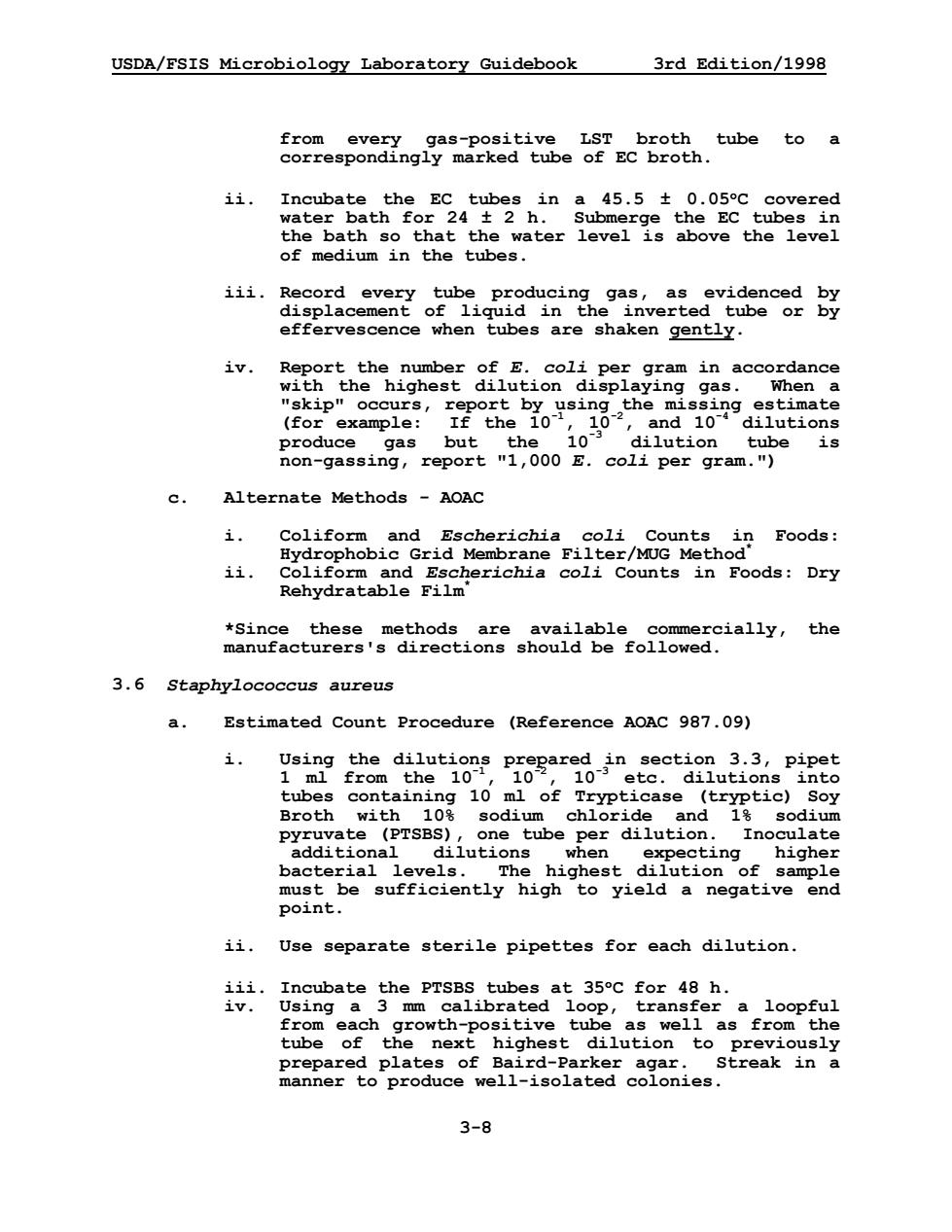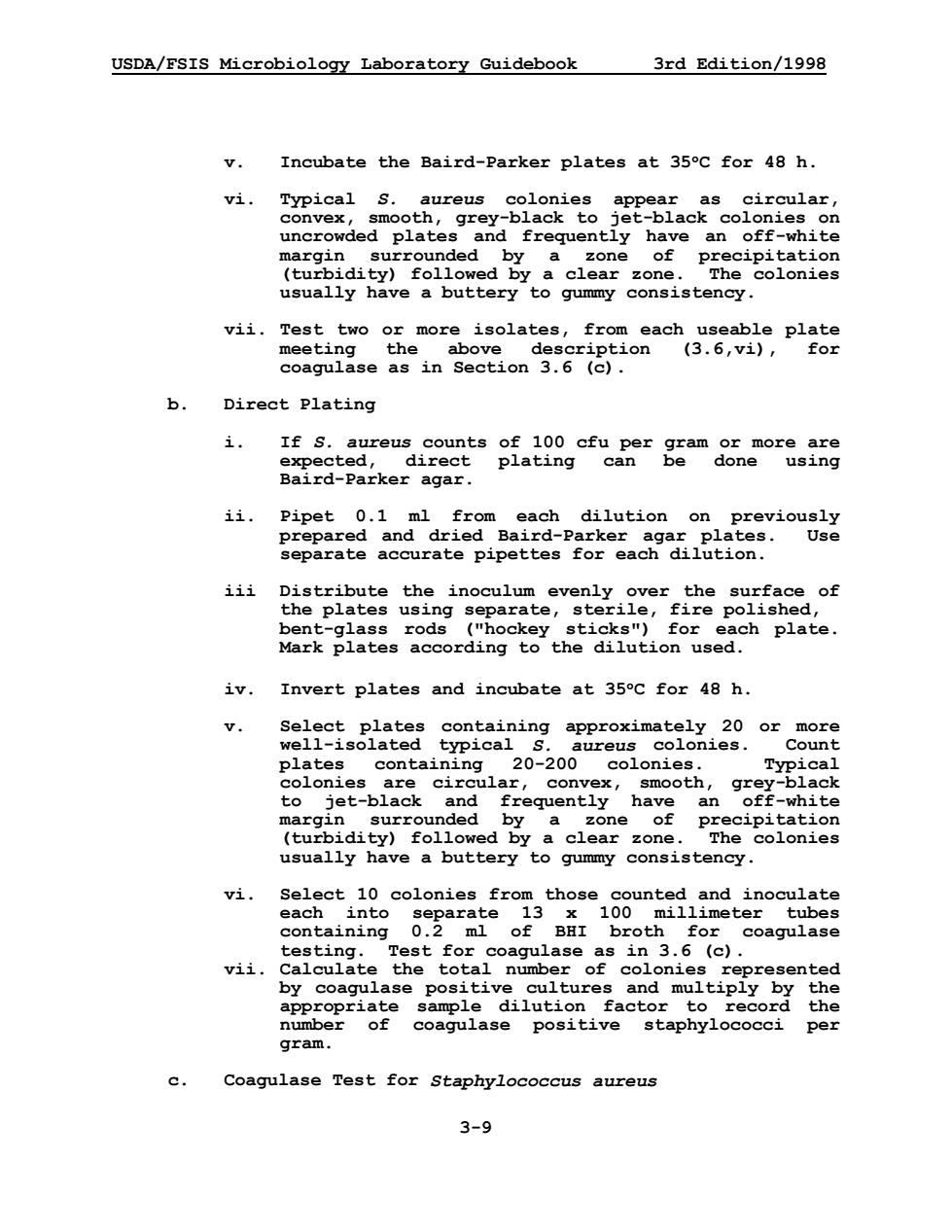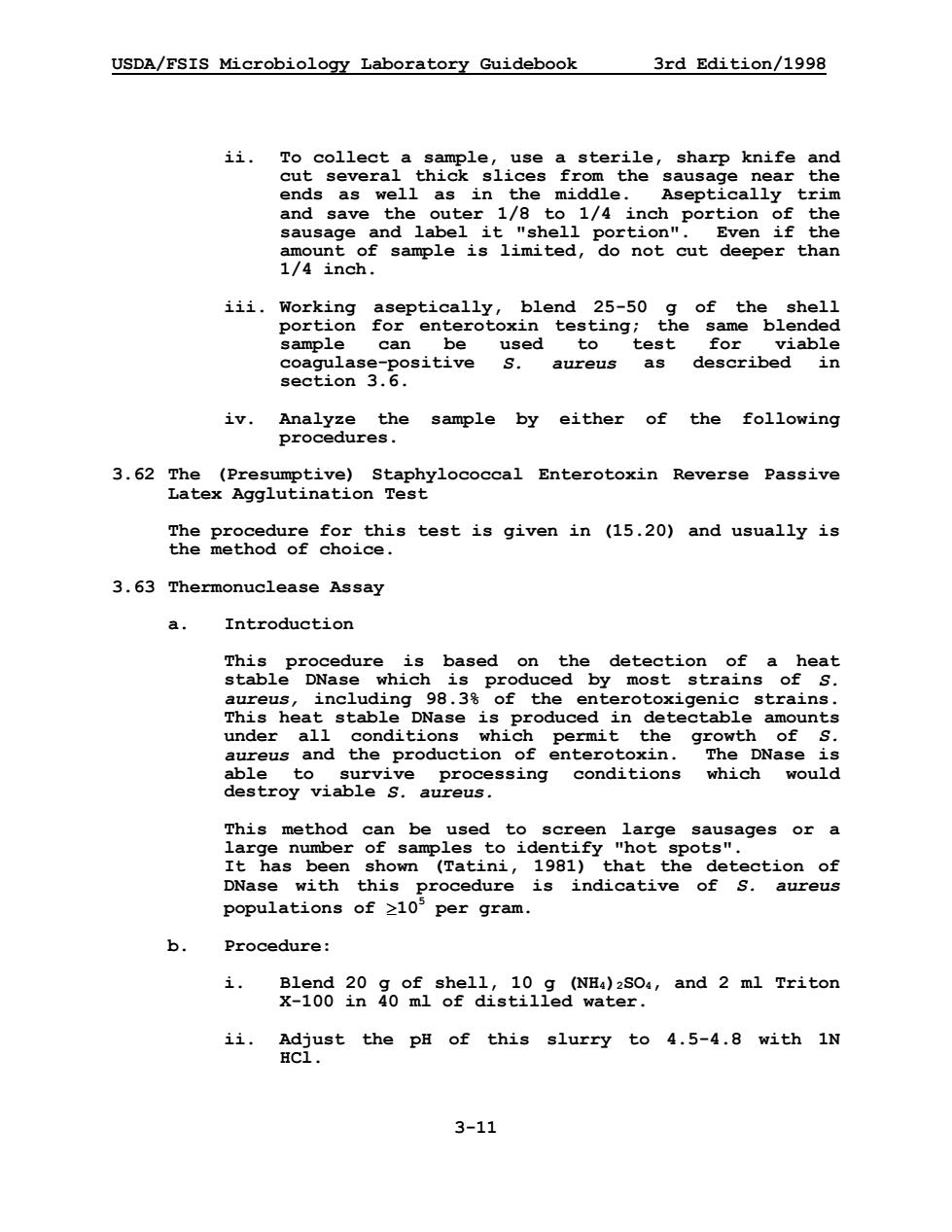
USDA/FSIS Microbiology Laboratory Guidebook 3rd Edition/1998 20e300nc81o026o1685oa. 30-300 cord the dilution o. nted and Aver ge the counts multiply by the factor and report this as b. Alternate Methods -AOAC i. Grid ii. A0Ac990.12) Film (Petrifilm Aerobic PlateTM) iii.Spiral Plate Method'(AOAC 977.27) these ethod are the .o 3.5 Coliform Group and Escherichia coli Estimated Count Procedure (Reference AOAC 966.24) Using the dilutions prepared in section 3.3,pipet i. from the 10 10 etc.dilutions :one be per do nto S The highest dilution of sa le must be sufficiently high to yield a negative end point. ii.Use separate sterile pipettes for each dilution iii. the tubes of LST broth at 35C for iv. pneetbey isplac the er fervescence when t v. Consider any tube of LST broth displaying gas as coliform positive, and report numbe of per gram i the using the missing estimate(for example:,里oha。 19102 and 10 dilutions produce gas but the colifoms pergam non-gassing,sepos000 dilution tube b. Fecal Coliform (E. coli)Estimated Count Procedure (Reference AOAC 966.24) i. Use a 3 mm calibrated loop to transfer one loopful 3-7
USDA/FSIS Microbiology Laboratory Guidebook 3rd Edition/1998 3-7 30-300 colonies, record the dilution counted and the number of colonies found. Average the counts obtained from duplicate plates, multiply by the dilution factor and report this number as the aerobic plate count per gram or milliliter at the incubation temperature used. b. Alternate Methods - AOAC i. Aerobic Plate Count in Foods: Hydrophobic Grid Membrane Filter Method* (AOAC 986.32) ii. Dry Rehydratable Film (Petrifilm Aerobic PlateÔ) Method* (AOAC 990.12) iii. Spiral Plate Method* (AOAC 977.27) *Since these methods are available commercially, the manufacturer's directions should be followed. 3.5 Coliform Group and Escherichia coli a. Estimated Count Procedure (Reference AOAC 966.24) i. Using the dilutions prepared in section 3.3, pipet 1 ml from the 10-1, 10-2, 10-3 etc. dilutions into LST broth, one tube per dilution. Inoculate additional dilutions when expecting higher bacterial levels. The highest dilution of sample must be sufficiently high to yield a negative end point. ii. Use separate sterile pipettes for each dilution. iii. Incubate the tubes of LST broth at 35°C for 24 ± 2 h. iv. Examine each tube for gas formation as evidenced by displacement of fluid in the inverted tubes or by effervescence when tubes are shaken gently. v. Consider any tube of LST broth displaying gas as coliform positive, and report the number of coliform per gram in accordance with the highest dilution with gas. When a "skip" occurs, report by using the missing estimate (for example: If the 10-1, 10-2, and 10-4 dilutions produce gas but the 10-3 dilution tube is non-gassing, report "1,000 coliforms per gram.") b. Fecal Coliform (E. coli) Estimated Count Procedure (Reference AOAC 966.24) i. Use a 3 mm calibrated loop to transfer one loopful

USDA/FSIS Microbiology Laboratory Guidebook 3rd Edition/1998 from every gas-positive LST broth tube to a correspondingly marked tube of Ec broth. ii. Incubate the Ec tubes in a 45.5t0.050c covered for 24 2 e BC the vel iii. .c e shake en gently. iv.Report the number of E.coli per gram in accordance with the highest dilution displaying gas. When a produce gas but the 10 dilution tube is non-gassing,report "1,000 E.coli per gram.") Alternate Methods -AOAC 1. Coliform and Escherichia coli Counts in Foods: G Method ii. o6ow6。aoo:g *Since these methods are available manufacturers's directions should be forgomedcially,the 3.6 Staphylococcus aureus a. Estimated Count Procedure (Reference AOAC 987.09) i. 02n tubes containing 10 ml of Trypticase (tryptic)Soy Broth with 0 and 18 sodium (PTSBS lutio Inoculate bacterial levels. e hignont autiom oap must be sufficiently high to yield a negative end point. ii.Use separate sterile pipettes for each dilution iii.Incubate the pTSBs tubes at 35c for 48 h. iv. Using a 3 mm calibrated loop,transfer a loopful as from the next on to manner to produce well-isolated colonies 3-8
USDA/FSIS Microbiology Laboratory Guidebook 3rd Edition/1998 3-8 from every gas-positive LST broth tube to a correspondingly marked tube of EC broth. ii. Incubate the EC tubes in a 45.5 ± 0.05°C covered water bath for 24 ± 2 h. Submerge the EC tubes in the bath so that the water level is above the level of medium in the tubes. iii. Record every tube producing gas, as evidenced by displacement of liquid in the inverted tube or by effervescence when tubes are shaken gently. iv. Report the number of E. coli per gram in accordance with the highest dilution displaying gas. When a "skip" occurs, report by using the missing estimate (for example: If the 10-1, 10-2, and 10-4 dilutions produce gas but the 10-3 dilution tube is non-gassing, report "1,000 E. coli per gram.") c. Alternate Methods - AOAC i. Coliform and Escherichia coli Counts in Foods: Hydrophobic Grid Membrane Filter/MUG Method* ii. Coliform and Escherichia coli Counts in Foods: Dry Rehydratable Film* *Since these methods are available commercially, the manufacturers's directions should be followed. 3.6 Staphylococcus aureus a. Estimated Count Procedure (Reference AOAC 987.09) i. Using the dilutions prepared in section 3.3, pipet 1 ml from the 10-1, 10-2, 10-3 etc. dilutions into tubes containing 10 ml of Trypticase (tryptic) Soy Broth with 10% sodium chloride and 1% sodium pyruvate (PTSBS), one tube per dilution. Inoculate additional dilutions when expecting higher bacterial levels. The highest dilution of sample must be sufficiently high to yield a negative end point. ii. Use separate sterile pipettes for each dilution. iii. Incubate the PTSBS tubes at 35°C for 48 h. iv. Using a 3 mm calibrated loop, transfer a loopful from each growth-positive tube as well as from the tube of the next highest dilution to previously prepared plates of Baird-Parker agar. Streak in a manner to produce well-isolated colonies

USDA/FSIS Microbiology Laboratory Guidebook 3rd Edition/1998 V. Incubate the Baird-Parker plates at 35c for 48 h vi.Typical s.aureus colonies ap pear as circular ve an ies.on convex,smooth,grey-black to jet-black colc uncro ded plate: frequently ha .te usually have a buttery to gummy consistency. vii.Test coagulase as in Section 3.6 (c). b.Direct Plating i. If S. nts ected direct Baird-Parker agar. ii. Pipet 01m1e and dried Baird-Parker Use separate accurate pipettes for each dilution. iii Distribu 1at。 the inoculum eve f;the surtace of bent-glass rods ("hockey sticks")for e Mark plates according to the dilution used. each plate iv.Invert plates and incubate at 35c for 48 h. v. or plates containing 20-200 colonies. Typical olonies are cir ular,convex, smooth, to jet-black an frequently have an (turbidity)followed by a clear zone usually have a buttery to gummy consistency. vi. 10 colonies fror inoculate containing 0.2 ml of BHI broth for coagulase testing. Test for coagulase as in 3.6 (c). vii. Calculate the tota number of se pos dilutio facto rd the number of coagulase positive staphylococci per gram. Coagulase Test for Staphylococcus aureus 3-9
USDA/FSIS Microbiology Laboratory Guidebook 3rd Edition/1998 3-9 v. Incubate the Baird-Parker plates at 35°C for 48 h. vi. Typical S. aureus colonies appear as circular, convex, smooth, grey-black to jet-black colonies on uncrowded plates and frequently have an off-white margin surrounded by a zone of precipitation (turbidity) followed by a clear zone. The colonies usually have a buttery to gummy consistency. vii. Test two or more isolates, from each useable plate meeting the above description (3.6,vi), for coagulase as in Section 3.6 (c). b. Direct Plating i. If S. aureus counts of 100 cfu per gram or more are expected, direct plating can be done using Baird-Parker agar. ii. Pipet 0.1 ml from each dilution on previously prepared and dried Baird-Parker agar plates. Use separate accurate pipettes for each dilution. iii Distribute the inoculum evenly over the surface of the plates using separate, sterile, fire polished, bent-glass rods ("hockey sticks") for each plate. Mark plates according to the dilution used. iv. Invert plates and incubate at 35°C for 48 h. v. Select plates containing approximately 20 or more well-isolated typical S. aureus colonies. Count plates containing 20-200 colonies. Typical colonies are circular, convex, smooth, grey-black to jet-black and frequently have an off-white margin surrounded by a zone of precipitation (turbidity) followed by a clear zone. The colonies usually have a buttery to gummy consistency. vi. Select 10 colonies from those counted and inoculate each into separate 13 x 100 millimeter tubes containing 0.2 ml of BHI broth for coagulase testing. Test for coagulase as in 3.6 (c). vii. Calculate the total number of colonies represented by coagulase positive cultures and multiply by the appropriate sample dilution factor to record the number of coagulase positive staphylococci per gram. c. Coagulase Test for Staphylococcus aureus

USDA/FSIS Microbiology Laboratory Guidebook 3rd Edition/1998 i. Use an inoculating needle to obtain a small amount Broth. ii. iii.Incubate each tube at 35c for 18-24 h iv.Add 0.5 ml of rabbit Pthemcturo2mg with EDTA, to v. and place the tubea in a 35-37C. vi. Examine these tubes each hour,from one through six clotting nterpret on 3.61 Special Sampling Procedure for Fermented Sausage Products a. Introduction During the early stages of sausage fermentation, staphylococci can ow extensively if the starter culture is not added fails with Failure anbe。a eed by or the improperuse ofostarter cultures or inoculation". oxinto the saus ge. as a resu growt Coagulase-positive staphylococcal counts on large sticks sti salami have been noted to vary widey 。上 reas may ha very tew st 107 eaataahnaeonaEaae7g5 nev in order to obtain a representative sample,portions should be taken from several different areas and composited for b. Procedure i. and proceed. ue pape 3-10
USDA/FSIS Microbiology Laboratory Guidebook 3rd Edition/1998 3-10 i. Use an inoculating needle to obtain a small amount of growth from each suspect colony and place it into 13 X 100 mm tubes containing 0.2 ml of BHI Broth. ii. A known coagulase positive and a known negative culture should be inoculated into BHI broth at the same time as the samples. iii. Incubate each tube at 35°C for 18-24 h. iv. Add 0.5 ml of rabbit plasma with EDTA, reconstituted according to the manufacturer's directions, to the BHI cultures. v. Mix thoroughly and place the tubes in a 35-37°C. water bath. vi. Examine these tubes each hour, from one through six hours, for clot formation. Any degree of clotting should be interpreted as a positive reaction. 3.61 Special Sampling Procedure for Fermented Sausage Products a. Introduction During the early stages of sausage fermentation, staphylococci can grow extensively if the starter culture is not added or fermentation fails with no concomitant production of lactic acid and drop in pH. Failure can be caused by poor quality starter cultures or the improper use of starter cultures or "back inoculation". S. aureus growth is aerobic and usually confined to the outer 1/8 inch of the sausage. Enterotoxin may be formed as a result of this growth. Coagulase-positive staphylococcal counts on large sticks of salami have been noted to vary widely. On large sticks, some areas may have very few staphylococci while other areas may have levels in excess of 106 /g. Whenever possible, obtain 1-2 pounds of the suspect sausage. In order to obtain a representative sample, portions should be taken from several different areas and composited for testing. b. Procedure i. If the sausage is moldy, wipe the mold off the sausage casing with a piece of sterile tissue paper and proceed

USDA/FSIS Microbiology Laboratory Guidebook 3rd Edition/1998 ii.To collect a sample,use a sterile,sharp knife and cut several thick slices from the sausage near the Asept aa and label it inch por n if the amgun ofncut deeper than 1/4 inch. iii.Worki ble 25-50 sample can be used to test for able 3 positive S. aureus as described 1n iv.Analyze the sample by either of the following procedures. 3.62 The the peegeduse go this test is given in (15.20)and usually is 3.63 Thermonuclease Assay a. Introduction gt品。25 hchr This procedure on of a heat aureus,including 98.3%of the enterotoxigenic strains. This nea t stable in d tectabl gro aureus and the production of enterotoxin. survive processing conditions which would destroy viable s.aureus. arge number of sampleto dentiy mhopoages or a This meth It has been shown (Tatini,1981)that the detection of DNase with this procedure is indicative of S.aureus populations of 210>per gram. b. Procedure: i.Blend 20 g of shell,10 g (NE)aSO4,and 2 ml Triton X-100 in 40 ml of distilled water. ii. the p of this slurry to 4.5-4.8 with IN 3-11
USDA/FSIS Microbiology Laboratory Guidebook 3rd Edition/1998 3-11 ii. To collect a sample, use a sterile, sharp knife and cut several thick slices from the sausage near the ends as well as in the middle. Aseptically trim and save the outer 1/8 to 1/4 inch portion of the sausage and label it "shell portion". Even if the amount of sample is limited, do not cut deeper than 1/4 inch. iii. Working aseptically, blend 25-50 g of the shell portion for enterotoxin testing; the same blended sample can be used to test for viable coagulase-positive S. aureus as described in section 3.6. iv. Analyze the sample by either of the following procedures. 3.62 The (Presumptive) Staphylococcal Enterotoxin Reverse Passive Latex Agglutination Test The procedure for this test is given in (15.20) and usually is the method of choice. 3.63 Thermonuclease Assay a. Introduction This procedure is based on the detection of a heat stable DNase which is produced by most strains of S. aureus, including 98.3% of the enterotoxigenic strains. This heat stable DNase is produced in detectable amounts under all conditions which permit the growth of S. aureus and the production of enterotoxin. The DNase is able to survive processing conditions which would destroy viable S. aureus. This method can be used to screen large sausages or a large number of samples to identify "hot spots". It has been shown (Tatini, 1981) that the detection of DNase with this procedure is indicative of S. aureus populations of ³105 per gram. b. Procedure: i. Blend 20 g of shell, 10 g (NH4)2SO4, and 2 ml Triton X-100 in 40 ml of distilled water. ii. Adjust the pH of this slurry to 4.5-4.8 with 1N HCl